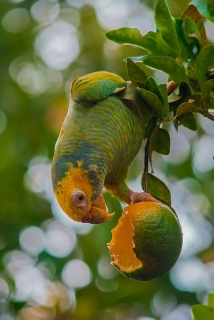Yellow-faced Parrot |
|
|
Photos
View in GalleryDid You Know?
According to research, in behaviour, appearance and chromosome type this species is not a typical Amazon; further studies indicated that it should be classified in another genus. The Yellow-faced Parrot also has two colour phases, one of which is male-linked.Academic Research
Related publications: Alipiopsitta xanthopsSpecies Profile
Genus: Alipiopsitta | Species: xanthops
Size:
27cm (10.5 in)
Weight:
260g (9.1 oz)
Subspecies including nominate:
one, with a green morph and yellow morph
Colour Adult:
Green morph: Both adults green in colour, the feathers widely edged darker green; yellow forehead and crown to around eyes and cheeks; yellow/orange ear coverts; deep orange sides of breast to flanks and axillary feathers; green tail with orange/red at base. Bill dull yellow with grey along ridge of upper mandible; pink/red cere. Eye ring white. Eye yellow.
Yellow morph: Male-head and neck entirely yellow; yellow/orange ear coverts; green upper breast washed with yellow, the feathers widely edged with darker green; dark yellow lower breast and upper abdomen, becoming orange/red on sides of breast to flanks, axillaries and inner lesser underwing coverts; yellow/green tail with red at base; pink/red cere and unfeathered lores. Female-yellow/green lower breast and upper abdomen, the feathers widely edged darker green.
Colour Juvenile:
Green morph: Duller than adults, with yellow confined to forehead, forecrown and area around eyes to ear coverts; rest of head green; green underparts, the feathers widely edged darker green. Eye brown.
Yellow morph: As in adult female but duller, with yellow confined to forehead, crown, and area around eyes to cheeks; rest of head green. Eye brown.
Call:
Calls made in flight are raucous; at rest softer and more musical.
Listen NowVideo Links:
Video 1More Information:
Content Sources:
CITES
BirdLife International
Cornell Lab of Ornithology/Birds of the World
Parrots: A Guide to Parrots of the World, Juniper and Parr, 1998
ML Collection Catalogue 170771, Yellow-faced Parrot Aliopsitta xanthops, Filadelfo, Thiago, Brazil, Oct. 19 2012, Cornell Lab of Ornithology Site
Parrots: Status Survey and Conservation Plan 2000-2004, Snyder, McGowan, Gilardi, Grajal, 2000.
Lexicon of Parrots, Thomas Arndt.
Parrots of the World, Forshaw and Cooper, 1977. 2010 edition
Parrots of the World, Forshaw, 2006.
Parrots in Aviculture, Low, 1992.
Photos
View in GalleryDid You Know?
According to research, in behaviour, appearance and chromosome type this species is not a typical Amazon; further studies indicated that it should be classified in another genus. The Yellow-faced Parrot also has two colour phases, one of which is male-linked.Academic Research
Related publications: Alipiopsitta xanthopsSpecies Care
Captive Status:
Rare in captivity.
Longevity:
20+ yrs
Housing:
Aviary or suspended enclosure, minimum length 3m (9.8 ft).
Diet:
Fruits such as: apple, orange, banana, pear, pomegranate, cactus fruits, forming about 30 or more percent of the diet; vegetables such as: carrot, celery, green beans and peas in the pod; green leaves such as: Swiss chard, lettuce, sowthistle, dandelion, chickweed; spray millet; fresh corn; small seed mix such as: millet, canary, and smaller amounts of oats, safflower and a little hemp; limited sunflower seed; cooked beans and pulses, and boiled maize and complete kibble.
Enrichment:
Enjoys bathing, so provide overhead misters or bowls of water; also is a vigorous chewer so provide bird-safe, unsprayed flowering branches, fir, pine, elder and willow boughs, vegetable tanned leather toys, wooden block toys, and lots of browse and different sized perches.
Nest Box Size:
Vertical 10" x 10" x 24" (25.4cm x 25.4cm x 61cm).
Clutch Size:
3
Incubation Time:
26 days
Fledging Age:
8 weeks
Hatch Weight:
12g (0.4 oz)
Peak Weight:
Not recorded.
Weaning Weight:
Not recorded.
Photos
View in GalleryDid You Know?
According to research, in behaviour, appearance and chromosome type this species is not a typical Amazon; further studies indicated that it should be classified in another genus. The Yellow-faced Parrot also has two colour phases, one of which is male-linked.Academic Research
Related publications: Alipiopsitta xanthopsSpecies Wild Status
World Population:
Unknown, decreasing.
IUCN Red List Status:
Near Threatened
CITES Listing:
Appendix II
Threat Summary:
A moderately rapid population decline is suspected due to habitat loss. At least two-thirds of the Cerrado region where the species is a specialist has been altered by agriculture, heavy cattle ranching, invasive grasses, pesticide use and yearly burning.
Range:
Interior of E and S Brazil, from S Piaui and S Maranhao south to Mato Grosso and W Sao Paulo; also to N and C Bolivia and N Paraguay.
Habitat:
Found up to 300m (984 ft) in deciduous and semi-arid deciduous woodlands and scrub, mostly cerrado woodlands with Mauritia palms; also drier caatinga scrub along riverways. May also be found around cultivated areas.
Wild Diet:
Feeds on seeds, unripe guava and mango. Forages on Caryocar brasiliense, Mimosa claussenii, Leucaena leucocephala, Qualea parviflora, Eriotheca pubescens and Pterodon emarginatus; also recorded eating soil (3%) and bark and feeding opportunistically on winged termites.
Ecology and Behaviour:
Seen in pairs and flocks of up to 35 individuals. Movements (seasonal or nomadic) poorly known. Peak foraging activity occurs in the morning and early afternoon.
Clutch and Egg Size:
3 elliptical eggs, 40.5 x 32.0mm (1.6 x 1.2 in).
Breeding Season:
May-October; nests in open area in cerrado trees or tall terrestrial termitaria.
Related Links:
Photos
View in GalleryDid You Know?
According to research, in behaviour, appearance and chromosome type this species is not a typical Amazon; further studies indicated that it should be classified in another genus. The Yellow-faced Parrot also has two colour phases, one of which is male-linked.Academic Research
Related publications: Alipiopsitta xanthopsMembers Only Resources
Please log-in now to find more research, resources and tools.
Not a Member?
Find more great information:
Gain exclusive access to 600+ pages of additional research, seminars and podcasts, specialists to ask your toughest questions, and dozens of other fun resources - when you become a WPT member.
Join Today >>

































